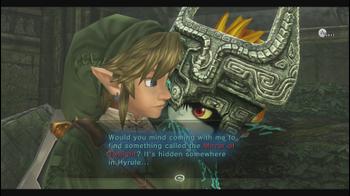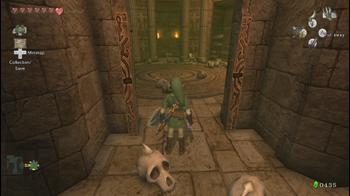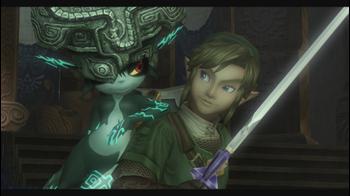
The Legend of Zelda: Twilight Princess HD Review
The Legend of Zelda: Twilight Princess has always been one of my favorite entries in the franchise. As other titles in the series started to get remastered editions on Nintendo 3DS and Wii U, I found myself imagining how Twilight Princess could be with cleaner visuals and some gameplay tweaks here and there.
When The Legend of Zelda: Twilight Princess HD was officially unveiled, one part of me was excited to revisit something I was particularly fond of, but I was also somewhat apprehensive that maybe my memories of the original would be tarnished nearly a decade later. Turns out my return trip was just as enjoyable as the first time around.
For this new HD version, let's start with the visuals - the game looks outright great. It's still a Gamecube game at heart, so you're not going to find intricate landscape geometries or overdone trees and plantlife, but new textures and improved resolution work excellently in bringing Twilight Princess to a high-definition console.
This particular art-style is a good mix between realism and fantasy, and the variety of locales are each gorgeous in distinct ways. From the fiery interiors of Death Mountain, the stoic stonework of the Temple of Time, and the eerie glyphs of the Palace of Twilight, there's no doubt this is one of the most visually remarkable and varied entries yet.
In the original version, muddy textures, especially in character models, hid some of the great looking art, but much of that has been remedied. Unlike The Wind Waker, whose HD remaster made some potentially awkward changes to an already incredibly unique art-style, Twilight Princess HD's visual improvements are essentially all for the better.
Outside of the enhanced visuals, the biggest change to the game is the addition of Hero Mode, which removes health drops and doubles damage received - just like in The Wind Waker's HD re-release. This is a notable increase in challenge early on when Link's total health is low and potions are hard to come by. Once the player collects a few bottles and Heart Containers, however, it becomes more than manageable.
If you want more of a challenge, you can use a Ganondorf amiibo to lower Link's defense even moreso on top of Hero Mode. Or you could always avoid picking up Heart Pieces in the first place.
Other changes to Twilight Princess HD include lower requirements to the three Tears of Light collection quests, which speeds up the pace early in the game ever-so-slightly. A few other adjustments are made throughout, such as only having to catch one fish during during the first tutorial. Also, those repetitive rupee notifications are gone this time.
One thing that Twilight Princess does especially well is how it handles its dungeons. Not only are they well-designed aesthetically, but structurally as well. None are too labyrinthine to be tedious or too simple to be merely routine.
The Arbiter's Ground notably has one of the more creative Zelda items in the series and has a good mix of combat arenas, puzzles, and wolf segments, capped off with a particularly memorable boss. Snowpeak Ruins is a unique and humorous design concept, with solid puzzles.
City in the Sky is the most maze-like dungeon in the game, with lots of incorporated verticality as you try and figure out the path you need to take. Even the Lakebed Temple handles its gimmick in a way that avoids the frustration found in other water-themed dungeons.
I find the overall world structure works quite well. It's large enough to give Hyrule a fair size, but never tedious to traverse, especially considering you get Epona and warp capabilities early on. There are plenty of Heart Pieces, Golden Bugs, Poe Souls, and Stamps - new to the HD version - to collect around the various fields, so taking time to explore around Hyrule feels appropriately rewarding. It avoids being overly formatted and structured like The Wind Waker's Great Sea
Also, while combat itself isn't necessarily a strength of the Zelda series, the Lost Hero character unlocking skills throughout the game helps to give Link a small array of abilities outside of just using different items. Blocking, evading, parrying, and otherwise using those abilities enhanced the encounter design just a tad when compared to other Zelda titles.
There are just a lot of little things that come together in Twilight Princess to make it so enjoyable.
Unfortunately, even Hero Mode doesn't really address the biggest issue I had with Twilight Princess ten years ago, and that's how simple many of the boss fights are. Despite some great dungeon designs, the boss monsters waiting at the end are often easily deciphered and beaten, almost pathetically so.
Armogohma, despite being an imposing giant tarantula, might be the the lamest boss monster in the series as he's taken out with a few arrows and Dominion Rod attacks that are impossible to miss. Argorok, a flying flame-breathing dragon, somehow manages to take what is undoubtedly a cool concept on paper and turn it into an exercise of monotony. There are a few standouts like Stallord, but most of these encounters are a miss.
Taking double damage can't fix these boss fights on their own when everything else is the same as before. At the very least, their own pool of HP could have been increased.
Where boss fights fail, the Cave of Ordeals succeeds. To effectively surpass this optional dungeon, the player has to know the best ways to dispatch the multitude of enemy types while managing their consumable items. This place is where the combat elements of Zelda gameplay are at their peak, with just enough challenge and length to have success feel rewarding while avoiding cheap frustration.
Despite all the things I like about Twilight Princess, there are certain parts of the game that drag the pace down more than necessary, oftentimes requiring the player to repeat their actions a second time. Examples of this include navigating through the Lost Woods or going back to the Hidden Village twice. Some of these odd padding decisions are scattered throughout the game, but never bothered me all too much - it's certainly not as efficient as it could have been.
Lastly, while narrative is not usually at the forefront when it comes to The Legend of Zelda, many of the characters and scenes in Twilight Princess always resonated with me more than other titles in the series. The story behind Midna and her history is well-presented; her demeanor is appropriate in the right places; her evolving disposition over the course of the game is believable; and ultimately constructs one of the strongest characters the series has seen.
Midna's gradual transformation from a mischievous avenger to trusted companion is captivating, and more importantly, heartfelt. The post-credits scene especially is probably the most emotionally rich that the series has to offer.
Supporting characters like Telma, Ilia, and Colin are never overbearing in the the storyline, but are present just enough to give the world of Hyrule, and Link himself, the player's sympathy. Despite being a silent protagonist, the interactions between Link and this cast gives him some character of his own.
Replaying through Twilight Princess was decidedly enjoyable and cemented it as one of my favorites. The somber tone, often melancholic music, an impressive slate of dungeons, and intriguing characters always felt simply comforting, in a way. The transition to HD and few tweaks made in this re-release have only improved on what was already a stellar game.



